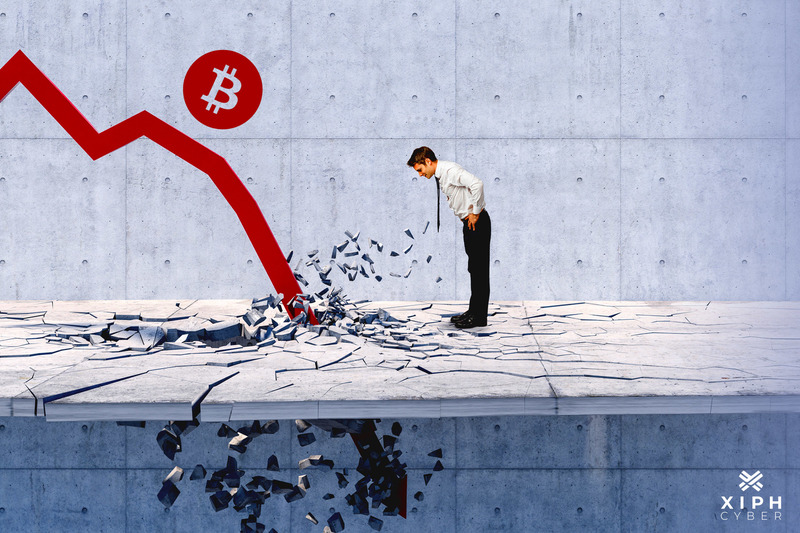Published Jun 23, 2022 by Xiph
The recent crypto crash has seen the value of most major cryptocurrencies plunge to an 18-month low, with the combined market value of all cryptocurrencies now reportedly less than $US1 trillion ($1.43 trillion). The increasing day-to-day volatility of digital currencies, rising inflation globally, and recent stock market fluctuations have led to speculations we could be heading for our longest crypto winter to date. So, is crypto dead or just bearing down for a comeback?

What’s caused the crypto crash of 2022?
The recent crypto crash can be attributed to a perfect storm of looming recessions, rising inflation, and stock markets around the world seemingly entering a bear market. As a result, big investors lost confidence in the market overall and started selling off their digital assets.
Then Luna (LUNA), the cryptocurrency associated with TerraUSD (UST) crashed. It was an event that had severe consequences for not only its investors but the crypto ecosystem at large. UST was an algorithmic stablecoin operated via computer codes that helped maintain its price equilibrium. The process involved burning or minting LUNA/UST to maintain the price of these tokens. When a UST was minted, $1 of Luna was burned, and vice versa. After a large amount of UST was dumped, the stablecoin lost its dollar peg, causing a bloodbath in the crypto market. Many investors lost their entire life savings. More UST was sold in a mass panic, minting more Luna and increasing the Luna circulating supply. This had the knock-on effect of then crashing the price of Luna.

The value of stablecoins is usually pegged to a fiat currency, usually the US Dollar. These exist primarily to allow crypto investors to get in and out of the fiat system and bypass banks. Most stablecoins are regulated and backed by reserves and therefore considered safer than other crypto coins.
Another reason most investors held TerraUSD was because of something called the Anchor Protocol, which is like a high-interest savings account that paid 20% interest — which is a really good deal for a savings account. Anchor then passed a resolution to replace the 20% rate with a variable rate which steadily reduced the rates holders received for holding UST. Naturally, UST holders began to sell in droves which caused further disruptions to the already unstable crypto market.
It’s easy to watch the peaks and troughs of crypto and dismiss the blockchain technology entirely, but despite its recent failings, crypto isn’t going away or dying anytime soon.
What is crypto?
For those who’ve been living under a rock, cryptocurrency (crypto for short) is a digital asset and a digital form of money secured by cryptography that you can trade online via blockchain technology. Cryptocurrencies don’t exist as physical coins or notes, but as digital tokens stored in a digital ‘wallet’. Traders need a crypto wallet to buy, trade, or sell cryptocurrencies. These wallets securely store digital assets and protect as well as validate transaction information. However, no wallet is ever totally safe from cybercriminals, which is why using a secure smartphone like a Graphene OS or IntactPhone is the best way to avoid having your crypto stolen or cryptojacked.
Cryptocurrencies aren’t real currencies
The term cryptocurrency itself can be misleading. In fact, 99% of cryptocurrencies aren't currencies at all. Crypto is used to verify transactions, execute smart contracts, and run programs stored on a blockchain network.
Cryptocurrencies have no legislated or intrinsic value; they are simply worth what people are willing to pay for them in the market at any given time. This makes cryptocurrencies a highly speculative asset class. On the other hand, traditional currencies like the US dollar and the Euro (€) get part of their value from being legislated as legal tenders and circulate within traditional financial systems.
However, crypto proponents like the fact that cryptocurrency removes central banks from managing the money supply as they tend to reduce the value of money via inflation. Investors also argue that blockchain technology that underpins cryptocurrencies can be more secure than traditional payment systems. It’s also the reason an increasing number of companies worldwide including Microsoft, Amazon, Alibaba, PayPal, Tesla, and Samsung (just to name of few) now use some type of blockchain technology to support payments, logistics, and new projects.
While cryptocurrencies have been both praised and condemned for many years amid volatile price market cycles, the fundamentality and advantages of blockchain technology have always remained strong.
Understanding crypto market volatility
The crypto market is more volatile than other markets because of its infancy and decentralised nature, meaning it’s not regulated or protected by any specific monetary policy. It can bear the full brunt of all market forces at once.
At its core, the value of cryptocurrency is determined by supply and demand. When demand outstrips supply, prices go up and when there’s more supply than demand, prices go down. Demand for a cryptocurrency often increases when a new project on its respective blockchain gets announced or as its utility increases, such as when a company adopts it as a form of payment thus limiting the circulating supply. Events such as simple Twitter updates from billionaire and Tesla CEO Elon Musk have also impacted prices as seen with Bitcoin and Dogecoin.
Cryptocurrencies like Bitcoin have a fixed maximum supply, while others like Ethereum (ETH) have no cap on supply. Some cryptocurrencies have mechanisms that ‘burn’ existing tokens to prevent the circulating supply from growing too large and slowing inflation. Each cryptocurrency has a different monetary policy, although overall cryptocurrency networks rarely abide by a static set of rules.
All the aforementioned factors are what make the crypto market such a fledgling beast. It’s largely based on feelings and projections, investor and user sentiments, government regulations, and media hype.
Is the future of crypto in jeopardy?
The market credibility of cryptocurrencies may be in jeopardy in light of the recent crash, but many experts argue it’s merely a side effect of a troubled economy. Cryptocurrencies have long been prone to boom and bust cycles. These bubbles are built into the ecosystem, but the fundamentals of crypto remain promising − more companies are adopting it as a form of payment or to fuel new business opportunities. The crypto market has crashed many times in the past, only to return stronger and with more opportunities for astute investors. Crypto is not dead, it is merely going through the motions.
A final word
Crypto market woes aside, knowing how to securely store digital assets like cryptocurrencies and non-fungible tokens (NFTs) is important, so it’s essential for anyone interested in owning cryptocurrency to learn about safe storage and the concepts of both hot and cold wallets. For more information, contact us via email: enquiries@xiphcyber.com.
Posted in: Security


